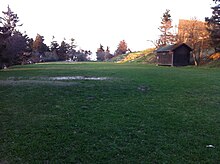Feldberg Festival
| Feldberg Festival | |
|---|---|

|
|
| sports |
Athletics hiking |
| Attendees | international |
| meeting | summer |
| Duration | several days |
| place | Great Feldberg in the Taunus |
| district | Hochtaunuskreis |
| state | Hesse |
| founding | June 23, 1844 |
| organizer | Feldbergfest committee |
| management | Rudiger Cornel |
| Website | feldbergfest.de |

The traditional Feldberg Festival (also called Feldberg Turn Festival ) on the Großer Feldberg ( 879 m above sea level ), the highest mountain in the Hessian Taunus , is the oldest mountain gymnastics festival in Germany, which first took place in 1844. It was a milestone in the gymnastics movement and was temporarily banned as part of the restoration . In 2006 the 150th Feldberg Festival took place.
history
prehistory
After the victory of the Battle of the Nations near Leipzig in 1813 , bonfires were lit on many mountains. At the beginning of the 19th century, mountains were considered a symbol of freedom and unity among patriotic citizens - and thus also the gymnastics movement . A large event of this kind with thousands of participants took place on October 18, 1814 with Ernst Moritz Arndt as the main speaker on the Großer Feldberg to celebrate the victory in the Wars of Liberation . This is one of the reasons why gymnastics clubs quickly use mountain peaks as destinations for hiking and gymnastics trips.
The first Feldberg Festival in 1844
In 1842, the later founder of the Taunus Club and enthusiastic Turner, August Ravenstein, together with the Usinger Fritz Emminghaus, founded a "Commission for the construction of a house on the Feldberg" with the aim of building a hiking home and a lookout tower (which was then built in 1902).
In order to raise money for this construction project, gymnasts and singers were invited to the first Feldberg Festival on June 23, 1844. The call had unimagined success. Over 200 active gymnasts and 6,000 visitors were counted. As a result, the annual continuation of this event was decided.
The Feldberg Festival and the restoration
In the following four years the Feldberg Festival took place with a growing number of participants. In 1848 10,000 visitors were counted.
With the failure of the March Revolution in 1849, persecution of the gymnastics movement began in Germany, which also affected the Feldberg Festival. The ban on the festival in 1849 by Landgrave Ferdinand von Hessen-Homburg could be avoided by switching to Nassau territory on the Altkönig . The attempt to organize “wandering folk festivals” instead of the Feldberg festival is only partially successful. The events are banned and broken up by the police. Instead, there are annual hikes to the Feldberg.
The Feldberg Festival as a tradition
The original Feldberg Festival was not held again until July 15, 1860. In the same year the Feldberghaus is inaugurated. The "Commission for the Construction of a House on the Feldberg" had fulfilled its purpose; the further planning and implementation was carried out by the "Feldbergfest committee". With the exception of the war years, the Feldberg Festival has been held every summer since then.
In 2006 the event took place for the 150th time.
Foundation of further mountain gymnastics festivals
The success of the Feldberg Turn Festival led to other mountain gymnastics festivals in the second half of the 19th century, for example the Elm Mountain Turn Festival near Braunschweig (1866), the Meißner Mountain Festival (1897) or the Rhönberg Festival (1905). Today there is a large number of mountain gymnastics festivals (see under web links).
See also
literature
- Paul Mess: The Feldberg Turn Festival . Marburg 1958
- Franz Wilhelm Beck: Mountain gymnastics festivals in Hessenland. Contribution to Hessian gymnastics history. Extended special print from: The Hessian Gymnastics Association. Handbook, Bad Vilbel 1968
- Feldbergfest Committee: Festschrift for the 150th Feldbergfest. 2006
Web links
- Feldberg Festival. In: Feldbergfest committee. feldbergfest.de, accessed on May 27, 2015 .
- Mountain gymnastics festivals. In: Peter Faust, Idstein. alt-idstein.info, accessed May 27, 2015 .
Coordinates: 50 ° 13 ′ 56.9 ″ N , 8 ° 27 ′ 22 ″ E
